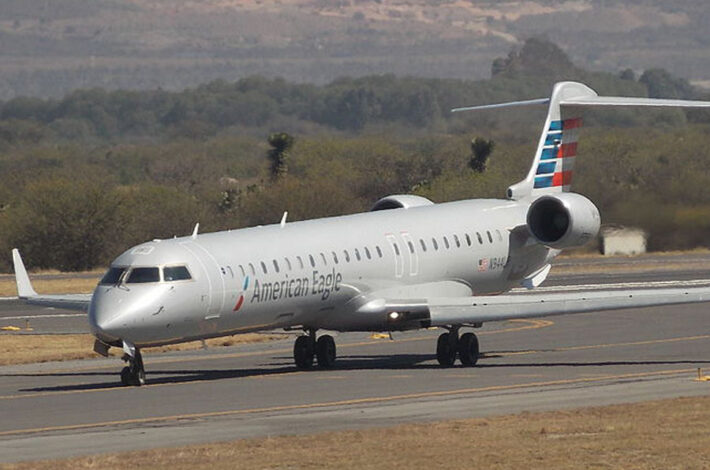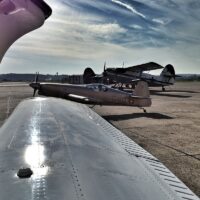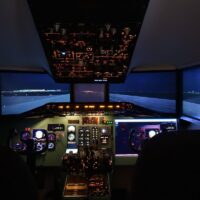
The Bombardier CRJ 900, an exceptional short to medium-haul regional aircraft, has gained significant acclaim since its introduction in 1991. Evolving from the CRJ 100/200 line, the CRJ 700 series paved the way for the CRJ 900, offering increased capacity and improved features. Production commenced in 2001, with the CRJ 900 serving as a stretched version of the CRJ 700. Notably, the two aircraft share a rating, allowing for cross-crew qualification with minimal training.
Enhancements included extended fuselage sections, augmented thrust, upgraded brakes and wheels, and additional service doors for enhanced crew accessibility and swift turnarounds. In February 2021, production of the CRJ 900 concluded, with a total of 491 units manufactured. The CRJ 900 was succeeded by the CRJ 1000, which offered a higher seating capacity of 100 passengers.
Bombardier CRJ 900 Specifications
The Bombardier CRJ 900 exhibits impressive exterior and cabin dimensions, as well as notable weights and performance metrics. The specifications are as follows:
Exterior Dimensions:
- Length: 118 ft. 11 in / 36.2 m;
- Height: 24 ft. 7 in / 7.5 m;
- Fuselage Max Diameter: 8 ft. 10 in / 2.7 m;
- Wingspan: 81 ft. 7 in / 24.9 m;
- Wing Area: 765 ft² / 71.1 m².
Cabin Dimensions:
- Length: 69 ft. 4 in / 21.13 m;
- Height: 6 ft. 2 in / 1.89 m;
- Width: 8 ft. 4 in / 2.55 m;
- Floor Area: 486 ft² / 45.1 m²;
- Volume: 2,974 ft³ / 84.21 m³;
- Cargo Volume: 594 ft³ / 16.8 m³;
- Cabin Bin Volume Per Pax: 1.9 ft³ / 0.05 m³.
Weights:
- Maximum Ramp Weight (Base): 80,750 lb / 36,628 kg;
- Maximum Ramp Weight (Max): 85,000 lb / 38,555 kg;
- Maximum Take-Off Weight (Base): 80,500 lb / 36,514 kg;
- Maximum Take-Off Weight (Max): 84,500 lb / 38,330 kg;
- Maximum Landing Weight (Base): 73,500 lb / 33,340 kg;
- Maximum Landing Weight (Max): 75,100 lb / 34,065 kg;
- Maximum Zero Fuel (Base): 70,000 lb / 31,751 kg;
- Maximum Zero Fuel (Max): 70,750 lb / 32,092 kg;
- Maximum Payload (Base): 21,840 lb / 9,907 kg;
- Maximum Payload (Max): 22,590 lb / 10,247 kg;
- Maximum Fuel Capacity: 19,595 lb / 8,888 kg;
- Cargo Weight: 6,075 lb / 2,756 kg.
Performance:
- Maximum Range: 1,553 nm / 1,787 mi / 2,876 km;
- High-Speed Cruise: 0.82 Mach / 470 kts / 541 mph / 871 km/h;
- Standard Cruise: 0.78 Mach / 447 kts / 515 mph / 829 km/h;
- Maximum Operating Mach Number (Mmo): 0.82 Mach;
- Fuel Burn (Average): 396 gal / 1,500 l;
- Takeoff Distance (SL, ISA, MTOW): 6,360 ft / 1,938 m;
- Landing Distance (SL, ISA, MLW): 5,360 ft / 1,630 m;
- Service Ceiling: 41,000 ft / 12,497 m;
- Rate of Climb: 2,000 fpm / 10.16 m/s;
- Rate of Climb (Single Engine): 1,200 fpm / 6.09 m/s;
- Rated Takeoff Thrust (each): 13,360 lbf / 59.4 kN;
- Rated APR Thrust (each): 14,510 lbf / 64.5 kN;
- Noise Level (Flyover): 82.2 EPNdB;
- Noise Level (Approach): 92.4 EPNdB.
Systems:
- Flight Deck: Rockwell Collins Pro Line 4 with six-screen EFIS/EICAS;
- Engine(s): 2 General Electric CF34-8C5 Turbofans;
- Auxiliary Power Unit: Honeywell RE220.
Bombardier CRJ 900 Performance and Flight Characteristics
The Bombardier CRJ 900 surpasses its competitors in terms of power and speed. Its two General Electric CF34-8C5 turbofan engines generate an impressive combined thrust of 29,020 lbf (130 kN). This allows the aircraft to reach a service ceiling of 41,000 ft (12,497 m) and achieve a top speed of 0.82 Mach (470 kts). The engines are responsive, providing pilots with ample power for go-arounds when needed.
Ensuring Safety: Modifications and Options
The CRJ 900, a rear-engine T-tail aircraft, is equipped with safety features like stick shakers and pushers to prevent deep stalls. In the unlikely event of a deep stall, the CRJ 900’s powerful engines have sufficient thrust to recover from the situation.
Tailored Configurations and Options
The CRJ 900 offers four primary configurations: triple class, dual-class, single class, and the max. These configurations vary in seat capacity, with 76, 81, 88, and 90 seats respectively. Business class seats are available in the triple and dual configurations, with 12 and 9 seats respectively. The single and max configurations feature standard seating, with the max accommodating two additional seats near the aft lavatory.
Discover the Competitive Price
The CRJ 900’s success can be attributed, in part, to its competitive pricing. In 2018, the list price for a CRJ 900 was $48 million. However, airlines often benefit from bulk purchases, with American Airlines acquiring 15 units at less than $20 million each. The market value of a CRJ 900 depreciates rapidly, with the average price in 2018 being $24 million, and even older models selling for as low as $14 million. The aircraft’s quick depreciation is mainly due to its role as a regional aircraft with frequent turnarounds, depreciating nearly 10 percent in 2021 alone.
Operational Costs Breakdown
Operating the CRJ 900 involves fixed and variable costs.
Fixed Costs
Fixed costs, unaffected by aircraft usage, include annual inspections, crew salaries, crew training, parking fees, insurance, and miscellaneous expenses. The total annual fixed cost for a CRJ 900 is approximately $1,243,000. The breakdown of fixed costs is as follows:
- Lease Cost: $912,000;
- Crew Salary: $163,200;
- Crew Training: $50,000;
- Parking: $30,000;
- Insurance: $48,000;
- Miscellaneous: $40,000.
Lease Cost
The rapid depreciation of the CRJ 900 affects lease values, with an 8.3% decrease in market value in 2021. A 10-year-old aircraft’s monthly lease cost ranges from $76,000 to $84,000.
Crew Salary
Regional airline pilots’ salaries vary, with first officers starting around $43,200 per annum and captains earning $120,000 per annum. The estimated cost per flight crew is $163,200, excluding insurance and other benefits.
Crew Training Costs
Training costs for CRJ pilots depend on existing fleet experience. A simple 3-day course is required for pilots transitioning from CRJ 700s. In cases requiring ground-up training, the type rating cost can reach up to $20,000. Additional costs include proficiency checks and medical examinations, with an estimated annual cost per crew of around $10,000.
Parking Costs
Ramp parking, the most cost-effective method for regional airlines, incurs minimal expenses. Storing the aircraft in a hangar provides protection but comes at a higher rental cost. On average, storing a single CRJ 900 in a hangar costs approximately $30,000 per year.
Variable Costs
Variable costs, influenced by usage, include fuel, maintenance, and operating fees.
- Fuel represents the largest variable cost, with the CRJ 900 consuming approximately 655 gallons per hour. Fuel costs vary based on economic factors and location, with an average cost of $3.95 per gallon in the United States. This results in an hourly fuel cost of around $2,600;
- Maintenance costs are the second-highest variable expense. Frequent short trips, typical for regional airlines, contribute to increased wear and tear on the aircraft. The landing gear and engines experience added strain due to frequent takeoffs, landings, and thrust reverser usage.
Conclusion
The CRJ 900 stands out as a remarkable aircraft, offering a blend of agility, comfort, and efficiency for air travelers. Equipped with safety features to prevent deep stalls and powerful engines for recovery, it ensures a secure journey. With various configurations and seating options, the CRJ 900 caters to diverse passenger needs. Its competitive pricing, coupled with rapid depreciation, makes it an attractive choice for airlines. While operational costs include fixed and variable expenses, careful management can help optimize efficiency. From its impressive performance to its cost-effective operations, the CRJ 900 continues to be a preferred choice for regional air travel.

